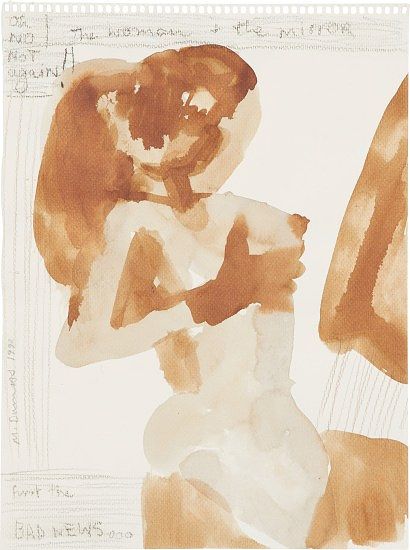Marlene Dumas, The Reflection, 1992. Estimate $70,000 - 100,000. 20th Century and Contemporary Art New York.
Marlene Dumas’ works circulate around psychological themes of the human condition: love, death, sexuality, and memory. Mining imagery from pop-culture, newspaper clippings and decontextualized film stills, as well as her own photographs of family and friends, Dumas’ phantasmagorical faces and distorted bodies challenge the distinctions between context and origin. This selection of eleven intimate drawings and paintings made between 1987 and 2001, from the collection of the late Edward Blake Byrne, is representative of Dumas’ oeuvre in which the artist isolates and fragments her figures.

Marlene Dumas, Helena Sleeping, 1989. Estimate $15,000 - 20,000. 20th Century and Contemporary Art New York.
Inspired by the birth of her daughter Helena in 1989, Dumas has consistently explored the stages of motherhood, beginning with pregnancy and birth. The anticipatory sensation of motherhood is reflected upon in works such as Not born Yet, 1990, Baba Soldaat, 1990, and A Little Devil, 1989. The reality of childbirth and motherhood is felt especially in Baba Soldaat, where an infant with exaggerated proportions stands before the viewer with a soft swirl of pigment sitting in place of a fully developed face.
In Helena Sleeping, 1989, Dumas invites viewers to observe imagery culled from the registers of her intimate experiences with her daughter. In this work, each feature of the infant’s face is depicted in great detail—the only element left to the viewer’s imagination is the subject’s placement within the black ink/wash haze that surrounds her seemingly disembodied head. This prevailing sense of obscurity is indicative of the metaphor of natural and artistic creation that underlines Dumas’s work. Similar to biological development, Dumas’s artistic practice urges the viewer to question the transmutation of the image as object and subject as well as the differences attributed to it once it takes on a new form.
Painting is about the trace of the human touch. It is about the skin of a surface. – Marlene Dumas
Unlike the works that center around the extensions of the self, The Reflection, 1992, looks inward and addresses issues surrounding self-perception. In The Reflection, a figure shrouded in darkness sits in front of a mirror while her reflection reveals an alternate depiction of her—a phantom-like presence constructed from a thin coat of white and grey paint. The difference between the figure’s body and their own reflection taps into an ongoing theme that characterizes Dumas’s methodology of interrogating the division between one’s public and private self. "I am dealing with emotions that everyone feels. But I'm always conscious of this tension between knowing that you are making an object, a physical thing, and being aware that you are also referring to things [the emotions] that cannot actually be painted. If the painting works, that tension is in there."

Marlene Dumas, The Woman and the Mirror, 1990. Estimate $12,000 - 18,000. 20th Century and Contemporary Art New York.
The ineffability of emotion is extended in Dumas’s exploration of the erotic—one of Dumas’ most sought after subject matters. In The Woman and the Mirror, 1990, a woman stands nude against a white background while one gloved hand grasps at her breast and another covers her face. Her gestures obscure the typical signifiers of the ecstatic experience, distancing the erotic nature of this work from the pornographic. Known for her preference for suggestive scenes rather than narrative ones, Dumas urges the viewer to seek other cues that would allow them to approach her subject. The unconstrained contours of the nude as well as the liquid and almost formless attributes of the watercolor deepen this work with a sense of vulnerability akin to the erotic. Dumas works with this phenomenon, its openness and fluidity as well as its ability to transcend public and private spheres, in order to bring its peculiarities to light.
Discover More from 20th Century and Contemporary Art >

Recommended Reading
Christina Quarles: A Fragmented Union >
Emerging Talent: 12 Artists to Watch >
